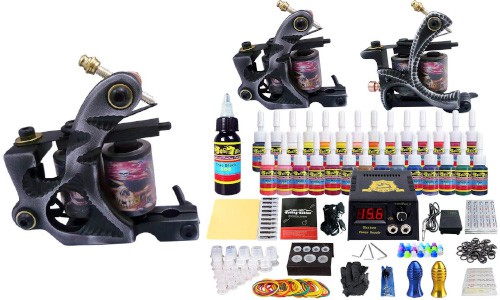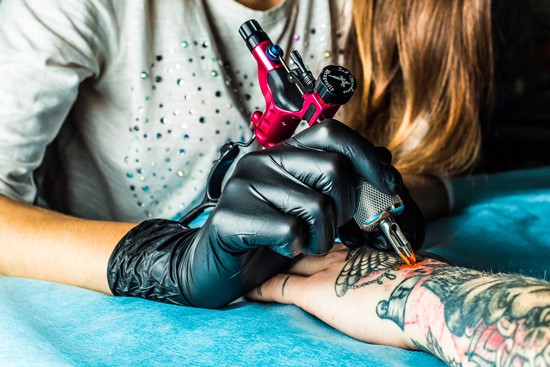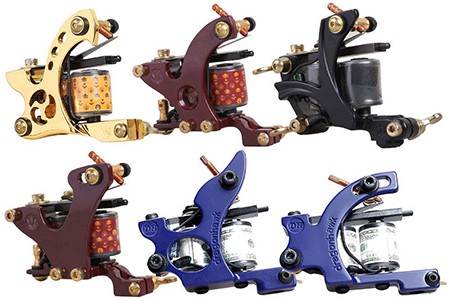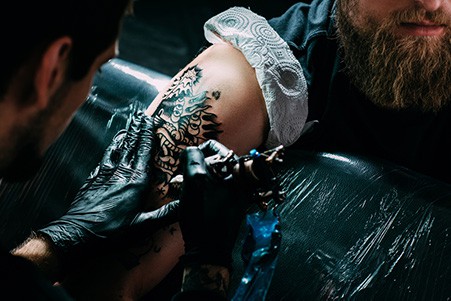Find out about the best tattoo numbing creams available, including how to use them for the most long-lasting effect, and which one is our top pick on the market
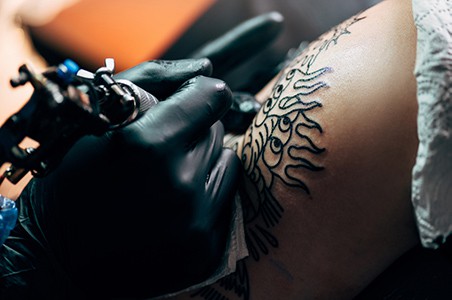
Editor’s note: Just to be clear, we are not trained medical professionals. This article and its contents are just our opinion and should not replace the advice of a physician.
Do You Really Need Them?
There’s nothing quite like a new bit of ink, but to get that sassy new tattoo you’ll have to face the pain first. There’s no escaping the fact that tattoos can hurt quite a bit, even if you’re a towering, musclebound hulk.
The anticipation of the pain can be enough to deter many people from getting a tattoo, particularly first-timers. TV tattoo shows which capture every lip-biting moment don’t help, revealing every grimace as the individual grits their teeth and tries to get through the experience.
Tattooing does involve needles penetrating your skin, which of course has millions of nerve endings that receive pain to give you that awful feeling of being pricked intensely with a sharp object.
But could there be an easier way to get a tattoo without having to endure so much pain in the process? If you’re longing for a tattoo but the pain is just too much of a deterrent, we could have the solution. Numbing creams are gaining in popularity and can help to dull the sensation in your skin, making tattoos far easier to bear.
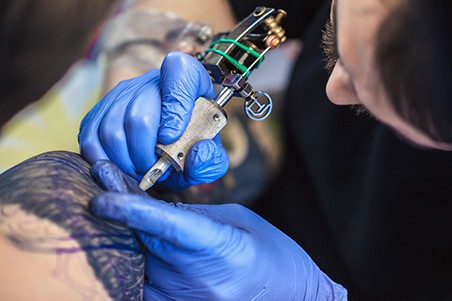
Of course, we’re not suggesting that tattoos aren’t ever going to hurt at all even with a bit of help. However, when you use a numbing cream, you could discover that it’s not really that bad. In fact, if you’re getting tattooed on the shoulder or calf muscle or another area that is less sensitive, you might be lucky enough to barely register a thing.
Sound good? Numbing creams can certainly take the edge off the pain and allow you to embrace the experience of being tattooed. But hold on a moment! Before you go rushing off to grab the strongest numbing cream you can find, it’s essential to know that you can’t use them all. Some numbing creams absolutely shouldn’t be used with tattoos and a few could even destroy your prized ink.
If you’re feeling confused, we’re here to help with this comprehensive guide to the best tattoo numbing creams on the market. Check out the information below and you’ll find everything that you need to know.
Recommended Next: Read our guide to tattoo starter kits.
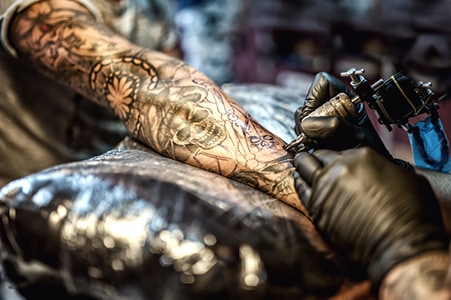
How They Work
Numbing creams can all look pretty similar at first glance. After all, you squeeze a blob out, smear it on your skin and wait for the numbness to kick in. Surely it’s not more complicated than that?
You might be surprised to discover that there are a variety of numbing creams available that work in different ways. It’s helpful to know the difference because you could find one particular type is more effective for you than another.
There are three main types of numbing cream for tattoos: nerve blockers, nerve deadeners, and vasoconstrictors. They work on the pain receptors in the body but each of them in a different way. Here’s a quick rundown of all three:
Nerve blockers
Local anesthetics are a type of nerve blocker, making the area of skin feel completely numb for medical procedures to take place. The ones used in hospitals are usually administered via injection, allowing minor surgery to take place without the patient feeling a thing!
Some tattoo numbing creams are also nerve blockers, but those available commercially are applied topically rather than injected. They work by minimizing the number of pain signals that can be sent to the brain, thus reducing the discomfort.
Topical nerve blockers aren’t completely effective in preventing pain from being felt as they’re not able to totally eradicate the messages being sent to the brain. They’re very good at taking the edge off the pain, but as the nerves are still working normally when used alone it’s common for pain to still be experienced.
For this reason, nerve blockers are often used in tandem with nerve deadeners, in a combination cream.
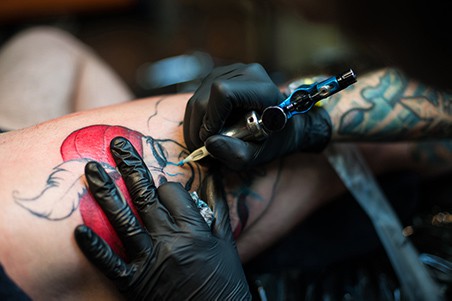
Nerve deadeners
As we’ve already explained, nerve blockers attempt to impair the pathways to the brain, stopping the pain message from getting through. Nerve deadeners take a different approach, preventing the nerves from operating at all.
As nerve deadeners stop nerves from working, they can be incredibly effective in relieving pain. This may sound perfect in principle but in reality, they don’t block all of the pain. The reason for this is that this type of cream cannot penetrate deep enough into the layers of skin.
The needles from the tattooist go beyond the surface level, triggering the nerves which lie within the dermis. This is a deeper layer of skin and the nerves within are unaffected by topical nerve deadeners.
This is the reason that nerve blockers are typically added to nerve deadeners to try and prevent the perception of pain in both ways.
Vasoconstrictors
The third type of cream doesn’t technically work directly on the pain receptors but nevertheless can still have a marked effect. Vasoconstrictors won’t numb your skin but will cause your blood vessels to contract. This not only slows down the absorption of chemicals but also shrinks the flow of blood.
Vasoconstrictors are often used with local anesthetics in hospitals as they prevent the medication from being distributed around the body. By constricting the flow of blood, more painkilling chemicals are retained in the desired area.
They work with numbing creams in a similar way, allowing the effect to last longer. This helps individuals to remain pain-free for longer during a tattoo.
An incidental but beneficial effect of the reduced blood flow is less bleeding on the tattoo site.
Recommended Reading: Don’t miss our guide to tattoo inks next.
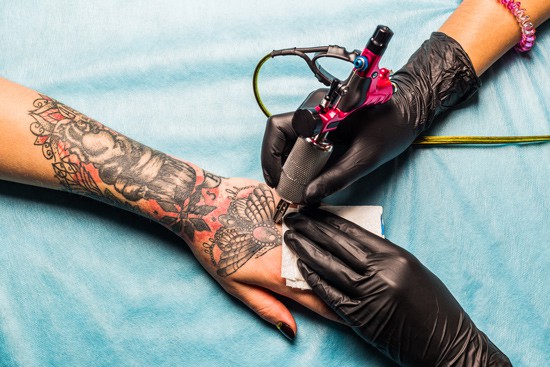
Buyers Guide
Now that you know how the different types of numbing cream work, we’re going to turn our attention to buying. Finding the best skin numbing cream for tattoos depends on a variety of factors.
Most numbing creams aren’t created specifically for tattoos. Instead, they’re a type of medicinal cream which numbs the area and is compatible with a range of uses, including tattoos. Other reasons a numbing cream might be used include cosmetic procedures, piercings, dental work, medical procedures, and optical surgery.
As you’ve seen from the section above, the way in which the creams work varies greatly and some have a better effect than others. Although all numbing creams reduce sensation in the skin, the ingredients which they contain can be very different.
Side effects
Although you’re unlikely to find a product that is developed solely for use with tattoos, it’s nevertheless important to check that it is compatible. Using a numbing cream that doesn’t list tattoos as a potential use could lead to unpleasant side effects, as well as affecting your ink. Some of the ways it could affect you include:
- Not numbing the area leaving you to deal with a painful tattoo
- Irritation of the skin causing additional discomfort both during and after the tattoo
- Preventing the tattoo ink being correctly taken up by the skin leaving you with a patchy and poor-quality design
In some cases, if the tattooist spots that you’ve used an incompatible numbing cream they may refuse to undertake the procedure, for the reasons given above.
Even if you do use the correct cream, it’s possible for side effects to develop. In the grand scheme of things, they tend to be pretty rare and usually only experienced by individuals with, particularly sensitive skin. Having an underlying skin complaint at the time of having a tattoo can be another risk factor.
When side effects do occur they are usually self-limiting and resolve quickly. Nevertheless, if you think you might be at risk of having an adverse reaction to the numbing cream, it’s always worth having a chat with your doctor in advance.
You may experience side effects immediately after the cream is applied or as a delayed effect. You should find that any unwanted effects resolve within 1-2 days at the most.
If you apply too much numbing cream and don’t follow the instructions, the side effects can be much worse. In some cases, they could even be serious. If you think you are suffering from anything more than a simple skin irritation then seek medical attention straight away.
The most common side effects that you may experience include:
- Redness
- Swelling and inflammation
- Minor irritation of the skin
- Itchiness
- A tingling or burning sensation at the site where the cream was applied.
Recommended Article: We discuss all things tattoo machine in our latest guide.
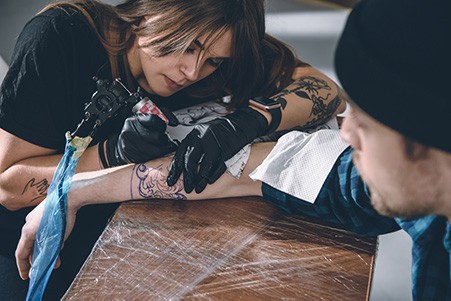
Effectiveness
Numbing creams have been sold in large numbers over the years and for good reason: they work. Everyone’s body works in the same way so there’s no reason for numbing creams not to work at all.
However, although numbing creams do work on everyone the degree of effectiveness will be hugely different. With differing nerve structures, varying skin thickness and personal sensitivities, the numbing cream will have a different effect on everyone that uses it.
Factor in different strengths and an assorted range of ingredients and it’s not hard to see why numbing creams aren’t guaranteed to work completely.
It’s important to be realistic about how effective the cream is likely to be. Many people buy numbing cream in the hope that it will freeze the area completely and leave them without any unpleasant sensations whatsoever during their tattoo.
It’s fair to say that it would be very unusual for a simple cream to eradicate every single shred of discomfort but for the vast majority of users, they reduce the pain significantly and make the procedure much easier to tolerate.
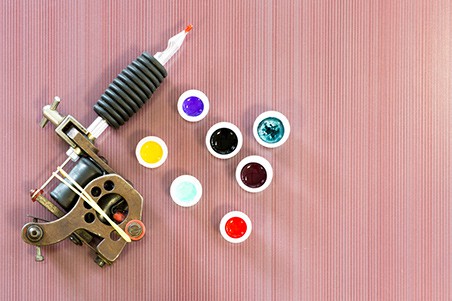
Applying the cream
The area of skin should be clean and free of oil and debris before you apply the numbing cream. This ensures maximum effectiveness and allows the cream to be absorbed properly by the skin.
Before squeezing the cream out, put on a pair of waterproof gloves. This will stop your hand and finger from going numb as you apply it.
The instructions may not specify this part, but it’s a good idea to wrap the area with the numbing cream applies in plastic wrap. This generates heat which allows the cream to work more effectively.
You’ll find the cream starts to work almost straight away so don’t put it on too long before you plan on having your tattoo. There’s no benefit in giving it longer to absorb into your skin before your tattoo, and if you wait the numbing effect could start to wear off too soon.
Before you apply the numbing cream, it’s a good idea to check with your tattooist about whether they have any specific rules. Some will only allow numbing cream which has been purchased from their studio because they want the assurance of only working with products they are familiar with.
Some tattooists don’t allow numbing creams to be used at all. If this is important to you, look around for another tattooist as many do permit the use of a cream. Try to avoid purchasing one which is glycerin-based as this makes the skin slippery and tattooists may be reluctant.
As a final note: remember that number creams are designed for use before the tattooing takes place. You may be a bit sore afterward but don’t be tempted to reduce the discomfort using the numbing cream. It may react with your skin and cause heavy inflammation around the tattoo, as well as impairing the healing process.
Recommended: Don’t forget to check out our guide to tattoo power supplies.
Recommended Tattoo Numbing Creams
If you need something to ease the pain then we recommend taking a closer look at one of these painkillers for the skin.
-
Ebanel 520 Topical Numbing Cream for Painkilling
[easyazon_image align=”center” height=”500″ identifier=”B019D7MQMK” locale=”US” src=”https://m.media-amazon.com/images/I/513RG0At9nL.jpg” tag=”thestyleup-20″ width=”500″]
This topical numbing cream from Ebanel is one of the top-selling products on the market and with good reason. It contains the highest amount of lidocaine that can be legally bought over the counter in the US, 5%, giving it the most powerful punch you’ll find in any numbing cream.
Some lidocaine creams have an unpleasant smell but this one is almost completely odor-free. It’s also non-greasy so won’t annoy your tattooist when they’re trying to work on your skin afterwards.
It soaks into the skin very quickly and is absorbed well for maximum results. This is partially due to the special formula which not only helps it start to work quickly, it also enhances the power of the lidocaine.
Ebanel 520 begins to work within 2-3 minutes of application and reaches its peak effectiveness about 25 minutes later. This makes it an extremely quick-working cream compared to some others on the market.
The numbing effect lasts for about an hour after its reached its peak, but it can safely be reapplied up to 6 times in 24 hours.
User reviews of Ebanel 520 have been excellent, with a high rate of effectiveness. Some users have found that the numbing sensation lasts for several hours, easily long enough to cover the typical tattoo experience.
Alongside the lidocaine, you’ll find the usual assortment of safe ingredients, with no toxic chemicals added. If for any reason you’re not totally satisfied with the effect, Ebanel have an outstanding track record in customer service, offering a no-quibble refund on the cream.
What we think: This is a well-priced cream but don’t let the price tag fool you, it’s just as effective as other numbing creams which are more expensive. This is one of the most popular numbing creams on the market and we’re not surprised. Top marks all round.
[easyazon_cta align=”center” identifier=”B019D7MQMK” key=”wide-orange” locale=”US” tag=”thestyleup-20″]
-
Super Numb Anesthetic Skin Numbing Cream
[easyazon_image align=”center” height=”500″ identifier=”B00NQJHM2Q” locale=”US” src=”https://m.media-amazon.com/images/I/51yvcOn5-OL.jpg” tag=”thestyleup-20″ width=”500″]
Another popular numbing cream, Super Numb is also made from 5% lidocaine just like the Ebanel 520, the previous cream. However, despite having the same strength of lidocaine, this cream isn’t quite as strong and won’t last as long.
This is partially because the special absorption technology isn’t present, which means the effects of the cream will start to wear off more quickly. The official description says that skin will be numbed for 3-4 hours but most users report that it’s only effective for 1.2-2 hours at most.
Super Numb is a water-based numbing cream so won’t leave an oily residue for your tattooist to slip around on. This is one of the reasons why this is a numbing cream that’s recommended for use with tattoos.
To get the full effect, it’s a good idea to apply the cream at least one hour before you have your tattoo and cover the area in plastic wrap. If you ask the tattooist to only uncover the bit they’re working on rather than the whole area, you can prolong the numbing effect. Once it’s unwrapped and residual cream wiped off, the clock starts to count down.
This numbing cream is extremely cheap but the tube is smaller than the others. The cream also needs to be spread quite thickly in order to work properly. One 30g tube will cover an area of skin which measures 6”x6” so you may need more than one if you’re having a large tattoo done.
What we think: This is an excellent numbing cream to start out with. It works well for most and the price tag won’t hurt your bank account. It’s not ideal for larger areas as it could work out a lot more expensive, and the effect may wear off too quickly.
[easyazon_cta align=”center” identifier=”B00NQJHM2Q” key=”wide-orange” locale=”US” tag=”thestyleup-20″]
-
UltraNumb Anesthetic Skin Numbing Cream
[easyazon_image align=”center” height=”456″ identifier=”B00NQGA7X0″ locale=”US” src=”https://m.media-amazon.com/images/I/41kdZLdITGL.jpg” tag=”thestyleup-20″ width=”500″]
This is a small tub of numbing cream, just 10g in size. Therefore, if you’re only having a small tattoo done or want to experiment with a skin numbing cream before paying out for a larger tube, this is an economical one to try.
Each 10g tub will cover an area approximately 4”x4” in size. Compared to Super Numb, this cream will go much further, making it a budget-friendly choice even for larger areas.
You’ll need to apply in significantly in advance of your planned tattoo for the best results. Apply one layer then begin to massage it well into the skin – don’t forget to wear your gloves to do this! After this, then you can apply more, creating a second, thick layer before wrapping with plastic and leaving for around two hours.
This creates the most effective results and you’ll find the area feels pleasantly numb. The results are powerful and long-lasting, giving you the option of pain-free tattoos for 3-4 hours. Just like Super Numb, you’ll get the most lasting results if the tattooist unwraps the skin bit by bit rather than exposing the whole area from the start.
The cream is non-greasy and works well for tattoos, as well as piercings and other aesthetic applications such as waxing.
What we think: This cream offers excellent value, saving money without compromising the effectiveness. It’s important to follow the instructions for application correctly if you want the best numbing effect, but when done properly, the results are excellent.
[easyazon_cta align=”center” identifier=”B00NQGA7X0″ key=”wide-orange” locale=”US” tag=”thestyleup-20″]
Conclusion
The above three products are some of the most popular on the market but which one is the best numbing cream of all?
They’re all well-priced so you won’t have to blow your budget to avoid the discomfort during your tattoo, but if economy is your priority then the UltraNumb pot probably just edges it. However, you’ll need to prepare well in advance and allow at least two hours for it to sink in properly.
If you do a little bit of your own research you might find some users claiming that these brands of tattoo numbing cream don’t work. It seems that they can be very dependent on the user. Make sure you follow the instructions carefully and see what they can do for you.
Although they all contain 5% lidocaine, the Ebanel 520 has the strongest and most lasting effect of them all. This is due to the special liposome formula which helps it to become easily absorbed. The botanicals included in the formula also help to ease redness and prevent skin inflammation.
The Ebanel 520 is also available as a tattoo numbing spray which can be easier for difficult to reach areas. This has the same efficacy and long-lasting numbness as the numbing cream.
Therefore, for us, the Ebanel 520 is the best numbing cream for tattoos, delivering affordability as well as powerful results, allowing you to enjoy the experience without the excruciating pain.



